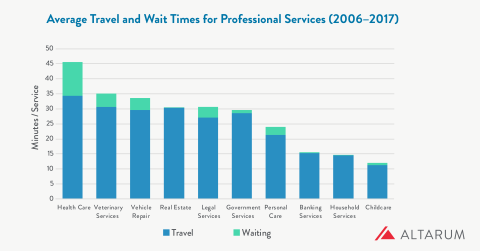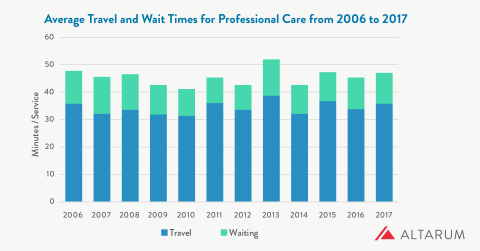
Travel and Wait Times Are Longest for Health Care Services and Result in an Annual Opportunity Cost of $89 Billion
Accessing professional health care services required on average 34 minutes of travel and 11 minutes of waiting, a burden that hasn’t changed over the past 11 years.
According to data analyzed from the Bureau of Labor Statistics’ American Time Use Survey from 2006 thru 2017, both health care travel and wait times were the longest when compared to other professional services like legal services, personal care, vehicle repair or even government activities like obtaining a permit/license. Waiting times for health care services in particular were much higher than the other service categories, over twice the length of the next closest, veterinary services. The time spent traveling and waiting for health care services on a day when an individual got care was over 50% of the time spent actually receiving care—45 combined minutes traveling & waiting vs. 76 minutes receiving care (data not shown). Among all time spent on health care related activities (self-care, assisting others, receiving professional care, waiting and travel), travel and waiting for care accounted for 19.7% of the total time spent, on average over two minutes a day or an hour per month.

Time spent on travel and waiting for care is an underappreciated burden of the US health care system. It results in a significant cost on patients, as individuals must forgo either leisure, work, or home activities in order to see a professional. When quantified by applying an individual’s hourly wage as an approximate measure of the economic cost of time spent, travel and waiting costs averaged $89 billion dollars annually from 2006 thru 2017. Despite significant investments in the United States over this period in improving access to health care through better insurance, the use of innovative delivery systems, and advances in digitizing health care records and automating administrative processes, travel and wait times show no discernable improvements in these data from 2006 to 2017. Travel and wait times represent an important measure of quality as they are key metrics of patient experiences and the time burden of care is a known hurdle for individuals seeking access to medicine.

Experts
